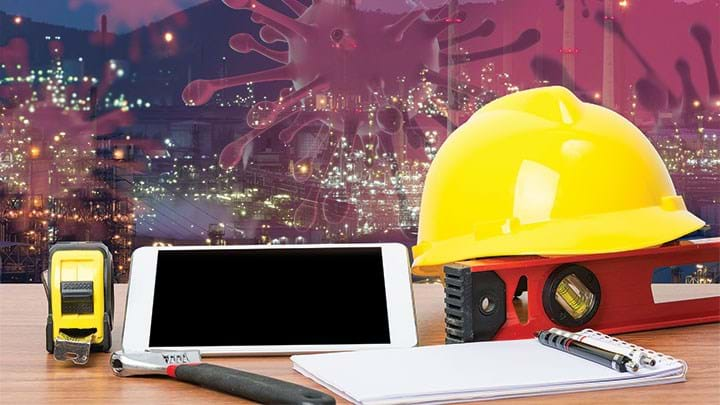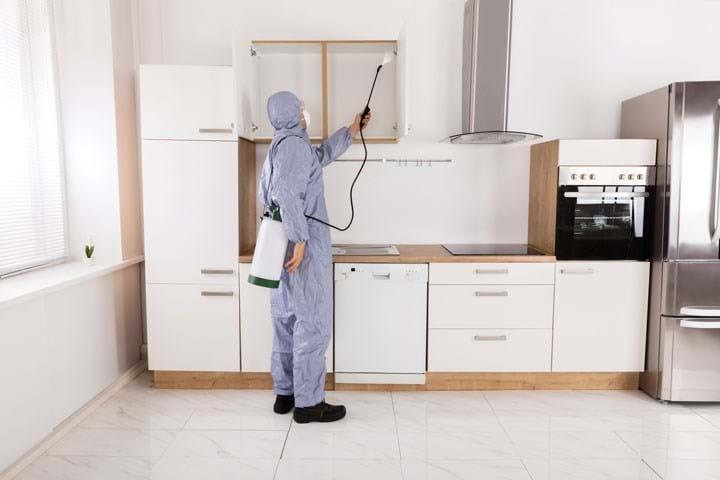Chemical Plants: Surviving the Coronavirus Storm

Joan Cordiner looks at how operations have adapted to the pandemic
THREE years ago, I shared my story about working and living in Houston during Hurricane Harvey (issue 916) and how I and my colleagues went about preparing our chemicals plants to survive the storm. What is clear with every hurricane I have worked through is that it’s our colleagues, their care for others, hard work and ingenuity that make the difference. That feels especially true today as we all learn to cope with the coronavirus pandemic.
In 2020, I returned with my family to live in the UK. One key reason pulling us home was access to the UK’s National Health Service (NHS); little did we expect that the NHS would come to dominate the news, and that the bravery of its staff and their importance to our lives would suddenly come into such sharp relief. Science and engineering have also come to the fore. There are government scientific advisors prominently providing press briefings alongside government leaders; modelling experts like those at Imperial College explaining the expected spread of the infection; chemicals firms building hand sanitiser plants; and people 3D-printing masks and parts for ventilators.
Who would have predicted just months ago that graphs, science, and engineering would dominate the daily news?
But, while this unexpected focus in the daily news cycle is necessary and welcome, what we don’t hear much about is how critical infrastructure such as chemical plants and power stations are being managed through this coronavirus storm we are now living through. A key question has emerged: are our existing natural disaster contingency plans sufficient?
Natural disaster policies put to the test
Over the last few weeks, friends managing and operating plants in the US and UK have told me how they are having to make rapid decisions to keep up with changing conditions.
Chemical plants, most of which are considered essential to keep operating have had to find a way of working that is very different than normal. But it turns out our carefully-designed and well-practised hurricane and flood policies are not quite a match for dealing with a global pandemic. I thought it would be insightful to look at why this is, and what we might learn about future preparedness.
Chemical plants, most of which are considered essential to keep operating, have had to find a way of working that is very different than normal
During a hurricane we have essential and non-essential staff, an Emergency Management team and on-call maintenance teams. These work for this situation. However, during a hurricane, the crews stay on site and sleep on site, on duty rota until transport links open back up again. Normally we shut the plant down as we have time to remove chemicals. We batten down the hatches for a few days. During a hurricane and in the immediate aftermath no-one is going to the site and the sites are locked to all other than the “ride out” crew.
However, in the case of Covid-19, we need to keep plants operating, which brings different challenges. Plants are continuing to operate, and policies are required to protect key personnel. For example, procedures have been written on who is allowed in specific site areas and when. This is complicated by the bimodal staff distribution in many plants: an ageing group coming near to retirement and another group with just a few years’ experience (replacing the baby boomers who retired in the last 10 years). The experienced older staff tend to be in very high risks groups (eg with chronic health issues, or from lifestyle choices). Identifying and protecting key technicians is paramount.
And this situation is further exacerbated by the push in recent years to optimise operations and slim down staffing to reduce costs. Minimal staffing reduces the numbers of relief technicians. Embracing just-in-time manufacturing has reduced stock in supply chains. This means that our ability to respond to shortages of people or raw materials is very much reduced and we are more likely to have staff working overtime and potentially must shut plants down.

Protecting our essential workers
Keeping our essential staff healthy becomes paramount. This means keeping everyone other than the shift technicians out of controls rooms and changing areas. Normally the control room would be open access for engineers, maintenance personnel and support staff. Now control rooms can only be accessed by others after a risk assessment and agreement from operations management for essential work; for example programming the DCS plant computer.
Whereas permit-to-work writing would normally be carried out with initial discussions in the control room and then walking out the job with the whole team in the field, now the request is radioed in, and one operations and one maintenance technician meet outside and walk the job, maintaining the 2 m social distancing requirement. They complete a risk assessment, including how to do the work with 2 m separation distances and adjusting PPE to protect against the virus. The maintenance technician then briefs the rest of the maintenance team. This has the impact of greater use of face masks, face shields and gloves for jobs that previously did not need them. In other cases, creative technicians have erected perspex screens to keep separation between people in the control room.
Laboratories also have limited access to essential personnel. While delivery drivers are required to stay in their cabs, plants are only accepting prearranged deliveries.
Finding new ways of working
For all of us, the last few weeks have been about sorting out the immediate and short term. That means improvements and reliability projects are most likely on hold. Protecting the sanctity of the control room and the health of the technicians becomes more important to ensure ongoing operations.
Those engineers and managers who are going into the site are doing so on alternating schedules to reduce numbers and their areas are kept segregated. The maintenance team has been sent home and is on call for urgent requirements for ongoing operations. As the lockdown period continues, prioritised planned maintenance is being done to comply with safety policies and regulatory requirements. Planned outages and turnaround may be delayed where they require large numbers of personnel to be on site and where parts are unavailable.
Engineers currently can’t walk the plant or go to control rooms to discuss issues with shift staff. Fortunately to allow remote working, we have gradually been introducing technology to allow the use of data historians (computerised records from plant sensors), drawings, photos and even live-streamed videos from technicians walking around the plant. In addition, engineers are using video conferencing to give training and interact with staff.
Keeping things clean
The cleaning of control rooms and meetings rooms has been carefully considered. Protocols have been developed and areas segregated to reduce transmission. People only access their own offices or labs and do not visit other areas. Common areas such as kitchens and changing rooms have new rules and all areas are being cleaned more regularly. Many facilities are keeping all non-essential staff off site on Fridays to allow thorough cleaning.

Sick leave and returning to work
Now people must take time off work, if they are having symptoms or have come in contact with a potential Covid-19 carrier. Some plants are measuring people’s temperatures before entry to the site. In addition, return-to-work policies have been written, largely following Government guidelines. For some this will lead to some working more “on-call” shifts to cover for sick or self-isolating colleagues. We have fatigue policies for the maximum number of days and hours that can be worked in a row. At some point there is a possibility that some plants or units will have to shut down due to lack of certified technicians.
Shortage of raw materials and risk management plans
As the lockdowns continue, plants must prepare for other shortages. Many raw materials come from China, which was in lockdown before the UK and some materials may run out, forcing units to shut down regardless of staff availability. Other supplies are also being impacted, for example PPE is in very short supply, if available at all. Activities requiring PPE may have to be prioritised and some low priority work delayed.
Supply chain managers are busy prioritising customers and which products to make. Companies will need to revise site risk management and supply-chain assessments. And not just for the duration of the current pandemic, or until a vaccine is provided globally. In our site and global risk assessments we will have to review our judgement of frequency and severity, and the mitigations we put in place for the risk of a future pandemics. We need to review strategies that reduce plant staff to a bare minimum or provide for flexible arrangements where engineers and other support staff are trained to maintain critical operations during crisis. In addition, we will have to review supply-chain minimum stock levels and look for new suppliers to separate their geographical risk.
What is very clear is that we need to do a review in each of our plants, businesses and in industry groups of what we should learn from this world-scale experience and what we need to do differently.
We need to do a review in each of our plants, businesses and in industry groups of what we should learn from this world-scale experience and what we need to do differently
Stress, fatigue and mental health of essential staff and their families
Amidst all this change and uncertainty there is real concern for our families and ourselves with this deadly disease. If we are being honest with ourselves, everyone will have had anxious moments. In addition, many are concerned about economic uncertainty affecting them or their families. Family takes precedence, and for many that means home-schooling children, and looking after elderly or sick family members. Daily life brings in new obstacles that must be overcome. For some this is all too much. Companies are sending out mental health information, ensuring people have buddies calling them regularly. I’ve had conversations with people who are stressed, feeling unproductive and concerned and just needed a conversation with someone from their normal daily working life. For some a good technical conversation was all that was needed. For others it’s a chance to talk about how they are feeling. Many though internalise their concerns and we hope that the materials provided on how to survive and thrive whilst working from home and during social distancing will help. Who would have thought that we would be looking forward to an online video meeting and waving at colleagues!

So, we have entered new working territory. The control rooms are quieter and non-essential staff are working from home. How will this impact our future ways of working? Technicians have been able to focus on their processes without constant interruptions. We must now review whether when the pandemic ends we want to continue excluding people from control rooms and using digital technology to gain the information we need to do our engineering jobs.
As engineers we often work together to solve problems and brainstorm ideas. Where we have previously used chance conversations in corridors to bounce ideas around or quickly test a theory, we are now using social media apps and quick “coffee break” video meetings. However, these fail to replicate the true camaraderie of seeing each other face-to-face and I question whether it is conducive to generating new ideas.
For some, being isolated at home with technology that permanently puts you just a click away from an ad hoc conference call can feel quite smothering. It probably feels like there is less space and time to concentrate, especially for those with young families. On the flipside, those who don’t have children or other family to care for may relish the time that less commuting frees up for extra activities – such as writing this article.
Managers now have a choice to make. If home working has worked, they will have to decide whether to allow more of it to continue for those that want it when things return to normal. I hope that managers will not regress to less flexible ways of working as a backlash to the time people spent at home.
Some companies have struggled to hire in some locations, perhaps they will consider hiring people who live further away, acknowledging the ability to work offsite some days a week or a week on site and a week at home. I did this with a very experienced engineer, flying him in from Alabama to Houston Monday-to-Thursday every other week. I thoroughly recommend using this as a useful additional approach.
Managers now have a choice to make. If home working has worked, they will have to decide whether to allow more of it to continue for those that want it when things return to normal
On a personal note, I’ve enjoyed working from home. I’ve enjoyed video meetings with colleagues and seeing their children and pets. I enjoy working with a view of the lambs running about in the fields outside rather than the chemical plants I’ve looked over for the last 30 years. Others, I know, are less fortunate.
While our existing natural hazard preparedness plans have not been sufficient to handle this crisis, there is a lot we have learned and will continue to learn from how operations have adapted. Managers have a lot of decisions to make about what the new normal will look like when it comes to managing plants and their staff after the pandemic.
In the meantime, forge your path and your own Covid-19 story. I’m off to use more of my freed-up time to sew facemasks for local healthcare institutions.
Recent Editions
Catch up on the latest news, views and jobs from The Chemical Engineer. Below are the four latest issues. View a wider selection of the archive from within the Magazine section of this site.




